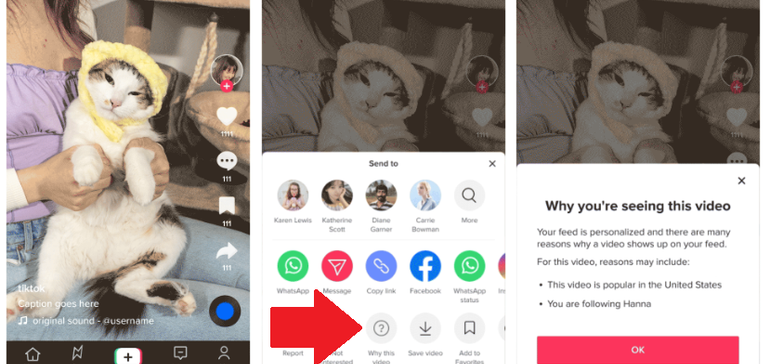SOCIAL
TikTok Looks to Provide More Insight into Why it Displays Each Video in Your ‘For You’ Feed

TikTok’s looking to provide more insight into why you’re seeing what you’re seeing in your feed with a new ‘Why Am I Seeing This?’ explainer tool that will provide some of the potential reasons that guide its algorithmic decisions.
As you can see in this sequence, now, in the ‘Share’ menu on any video clip in your feed, you’ll see a new ‘Why this video?’ option in the row beneath your social sharing options. Tap on that and you’ll get a couple of possible reasons as to why that specific video is appearing in your display.

It’s not a full explainer, and as you can see, the prompt notes that the reasons for displaying this specific clip ‘may include’ these qualifiers. But it provides some additional info to help you better understand how TikTok’s algorithm works, and why it thinks you might like this clip.
Meta provides similar for ads, with its ‘Why Am I Seeing This Ad?’ option, which will give you the same kind of generic insight into some of the possible reasons as to how you’re being targeted. Various social apps also provide notes like ‘Because you like [example page]’ when displaying recommended content in-stream, but it’s the first time that TikTok has provided more specific insight, in-app, as to how it’s algorithm functions.
Indeed, in its explainer post, TikTok says that:
“Our recommendation system is powered by technical models, so we tried to make the technical details more easily understandable by breaking down reasons like:
- user interactions, such as content you watch, like or share, comments you post, or searches
- accounts you follow or suggested accounts for you
- content posted recently in your region
- popular content in your region”
I mean, those are no where near how deep TikTok’s algorithms can go, with its system able to very quickly determine your likes and interests, in order to keep feeding you more of the same. But it’s something, and it could help you better understand how your interactions within the app guide what you then see, and are shown in your ‘For You’ feed.
The notes could also help marketers get a better understanding of the drivers of amplification in the app, which may help you better map out your strategic plan.
TikTok’s increasingly keen to provide more transparency, as a means to better ingratiate itself with local authorities. Questions continue to be raised around it’s potential obligations to the Chinese Government, while in the US, many states are now banning the app on Government devices due to concerns that the CCP could be tracking their activity.
Add to this the repeated calls to ban the app entirely at the federal level, and you can see why TikTok would be incentivized to show that there’s no external manipulation going on, that its systems are driven by your individual activity, not some other nefarious process.
Will this help to lessen such concerns? Probably not, but it does provide some more insight for your own usage, and it could help you better understand how it’s ultra-addictive algorithm operates.
SOCIAL
Snapchat Explores New Messaging Retention Feature: A Game-Changer or Risky Move?

In a recent announcement, Snapchat revealed a groundbreaking update that challenges its traditional design ethos. The platform is experimenting with an option that allows users to defy the 24-hour auto-delete rule, a feature synonymous with Snapchat’s ephemeral messaging model.
The proposed change aims to introduce a “Never delete” option in messaging retention settings, aligning Snapchat more closely with conventional messaging apps. While this move may blur Snapchat’s distinctive selling point, Snap appears convinced of its necessity.
According to Snap, the decision stems from user feedback and a commitment to innovation based on user needs. The company aims to provide greater flexibility and control over conversations, catering to the preferences of its community.
Currently undergoing trials in select markets, the new feature empowers users to adjust retention settings on a conversation-by-conversation basis. Flexibility remains paramount, with participants able to modify settings within chats and receive in-chat notifications to ensure transparency.
Snapchat underscores that the default auto-delete feature will persist, reinforcing its design philosophy centered on ephemerality. However, with the app gaining traction as a primary messaging platform, the option offers users a means to preserve longer chat histories.
The update marks a pivotal moment for Snapchat, renowned for its disappearing message premise, especially popular among younger demographics. Retaining this focus has been pivotal to Snapchat’s identity, but the shift suggests a broader strategy aimed at diversifying its user base.
This strategy may appeal particularly to older demographics, potentially extending Snapchat’s relevance as users age. By emulating features of conventional messaging platforms, Snapchat seeks to enhance its appeal and broaden its reach.
Yet, the introduction of message retention poses questions about Snapchat’s uniqueness. While addressing user demands, the risk of diluting Snapchat’s distinctiveness looms large.
As Snapchat ventures into uncharted territory, the outcome of this experiment remains uncertain. Will message retention propel Snapchat to new heights, or will it compromise the platform’s uniqueness?
Only time will tell.
SOCIAL
Catering to specific audience boosts your business, says accountant turned coach

While it is tempting to try to appeal to a broad audience, the founder of alcohol-free coaching service Just the Tonic, Sandra Parker, believes the best thing you can do for your business is focus on your niche. Here’s how she did just that.
When running a business, reaching out to as many clients as possible can be tempting. But it also risks making your marketing “too generic,” warns Sandra Parker, the founder of Just The Tonic Coaching.
“From the very start of my business, I knew exactly who I could help and who I couldn’t,” Parker told My Biggest Lessons.
Parker struggled with alcohol dependence as a young professional. Today, her business targets high-achieving individuals who face challenges similar to those she had early in her career.
“I understand their frustrations, I understand their fears, and I understand their coping mechanisms and the stories they’re telling themselves,” Parker said. “Because of that, I’m able to market very effectively, to speak in a language that they understand, and am able to reach them.”Â
“I believe that it’s really important that you know exactly who your customer or your client is, and you target them, and you resist the temptation to make your marketing too generic to try and reach everyone,” she explained.
“If you speak specifically to your target clients, you will reach them, and I believe that’s the way that you’re going to be more successful.
Watch the video for more of Sandra Parker’s biggest lessons.
SOCIAL
Instagram Tests Live-Stream Games to Enhance Engagement

Instagram’s testing out some new options to help spice up your live-streams in the app, with some live broadcasters now able to select a game that they can play with viewers in-stream.
As you can see in these example screens, posted by Ahmed Ghanem, some creators now have the option to play either “This or That”, a question and answer prompt that you can share with your viewers, or “Trivia”, to generate more engagement within your IG live-streams.
That could be a simple way to spark more conversation and interaction, which could then lead into further engagement opportunities from your live audience.
Meta’s been exploring more ways to make live-streaming a bigger consideration for IG creators, with a view to live-streams potentially catching on with more users.
That includes the gradual expansion of its “Stars” live-stream donation program, giving more creators in more regions a means to accept donations from live-stream viewers, while back in December, Instagram also added some new options to make it easier to go live using third-party tools via desktop PCs.
Live streaming has been a major shift in China, where shopping live-streams, in particular, have led to massive opportunities for streaming platforms. They haven’t caught on in the same way in Western regions, but as TikTok and YouTube look to push live-stream adoption, there is still a chance that they will become a much bigger element in future.
Which is why IG is also trying to stay in touch, and add more ways for its creators to engage via streams. Live-stream games is another element within this, which could make this a better community-building, and potentially sales-driving option.
We’ve asked Instagram for more information on this test, and we’ll update this post if/when we hear back.
-

 PPC6 days ago
PPC6 days agoHow the TikTok Algorithm Works in 2024 (+9 Ways to Go Viral)
-

 SEO5 days ago
SEO5 days agoHow to Use Keywords for SEO: The Complete Beginner’s Guide
-

 SEO7 days ago
SEO7 days agoBlog Post Checklist: Check All Prior to Hitting “Publish”
-

 MARKETING6 days ago
MARKETING6 days agoHow To Protect Your People and Brand
-

 SEARCHENGINES7 days ago
SEARCHENGINES7 days agoGoogle Started Enforcing The Site Reputation Abuse Policy
-

 PPC7 days ago
PPC7 days agoHow to Craft Compelling Google Ads for eCommerce
-

 MARKETING7 days ago
MARKETING7 days agoElevating Women in SEO for a More Inclusive Industry
-

 PPC7 days ago
PPC7 days agoHow to Brainstorm Business Ideas: 9 Fool-Proof Approaches














You must be logged in to post a comment Login